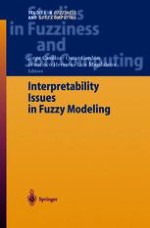2003 | OriginalPaper | Buchkapitel
Effect of Rule Representation in Rule Base Reduction
verfasst von : Thomas Sudkamp, Aaron Knapp, Jon Knapp
Erschienen in: Interpretability Issues in Fuzzy Modeling
Verlag: Springer Berlin Heidelberg
Enthalten in: Professional Book Archive
Aktivieren Sie unsere intelligente Suche, um passende Fachinhalte oder Patente zu finden.
Wählen Sie Textabschnitte aus um mit Künstlicher Intelligenz passenden Patente zu finden. powered by
Markieren Sie Textabschnitte, um KI-gestützt weitere passende Inhalte zu finden. powered by
An objective of merging rules in rule bases designed for system modeling and function approximation is to increase the scope of the rules and enhance their interpretability. The effectiveness of rule merging depends upon the underlying system, the learning algorithm, and the type of rule. In this paper we examine the ability to merge rules using variations of Mamdani and Takagi-Sugeno-Kang style rules. The generation of the rule base is a two part process; initially a uniform partition of the input domain is used to construct a rule base that satisfies a prescribed precision bound on the training data. A greedy algorithm is then employed to merge adjacent regions while preserving the precision bound. The objective of the algorithm is to produce fuzzy models of acceptable precision with a small number of rules. A set of experiments has been performed to compare the effect of the rule representation on the ability to reduce the number of rules and on the precision of the resulting models.
